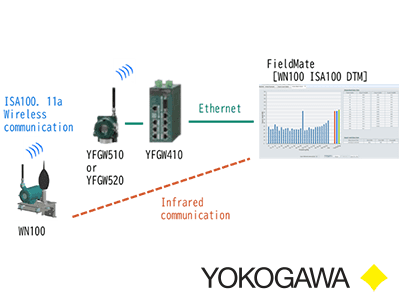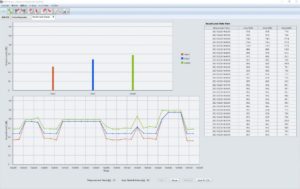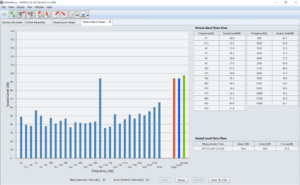
Introduction
Yokogawa Electric provides the wireless noise surveillance system, which improves plant safety by remote monitoring technology. This system is a new digital HSE system consisting of WN 30 noise map software and multiple WN 100 wireless sound level meters that provides a real-time noise monitoring system for high-noise environments such as offshore platforms. It was developed to prevent hearing impairment of workers and to optimize working hours limited by noise levels.
In addition, the application of the wireless noise surveillance system has been expanding not only for the HSE application but also for equipment condition monitoring. In this article, we introduce “Quick Monitoring by DTM”, which is expected to further expand applications.
Increasing expectations for machine condition monitoring applications
As a original specification, the wireless noise surveillance system has allowed for area-by-area noise maps, sound levels per WN 100 and constant monitoring of the frequency analysis data.
However recently, there has been requests from customers to utilize the sound level data and frequency analysis parameter of WN 100 as the data for noise monitoring and diagnosis of equipment failures and abnormalities with limited measurement targets in a minimum configuration consisting of WN 100 single unit and ISA 100 wireless communication.
WN100 ISA100 DTM
To meet the customer’s requests, Yokogawa’s new WN 100 ISA 100 DTM provides functions such as graph display, trend display, and log acquisition. This makes it possible to visually confirm changes in sound levels and frequencies without depending on the host system.
Combining the WN 100 ISA 100 DTM with the WN 100 makes it relatively easy to graphically display sound-level DATA and Trend displays via the ISA 100 wireless infrastructure or infrared communication with devices, as well as graphically display frequency analysis DATA. Thus, the difference between the normal condition and the abnormal condition can be noticed from, for example, the noise from the equipment such as a compressor, the noise from the surrounding environment, and the change of the frequency, and it becomes possible to correspond to the predictive maintenance.
Available sound level parameters
WN100 ISA100 DTM can shows three kinds of frequency weighted sound levels: LAeq, T (A characteristic time average sound level), LCeq, T (C characteristic time average sound level), and LCpeak (C characteristic peak sound level). The A characteristic is a frequency curve which is the same as the sensitivity of the human ear, and the sensitivity becomes low in low frequency and high frequency band. The C characteristic has a relatively flat shape compared with the A characteristic. LAeq, T and LCpeak are mainly used as a parameter for noise exposure limit and environmental noise. Moreover, the application as a conditioning monitor which detects the failure and abnormality of the equipment by the sound generated from the equipment is noticed from the change information of the frequency component by LCeq, T and LCpeak, 1/3 octave band analysis.
Figure. 1 and 2 show screen examples of a sound level viewer and an octave band viewer, respectively.

Figure 1: Sound Level Viewer

Figure 2: Octave Band Viewer
System Configuration
Figure. 3 shows an example of the system configuration of the package solution. WN 100 ISA 100 DTM is a standard package of FieldMate software installed on PCs. WN100 ISA100 DTM receives measurement data via ISA100 via wireless infrastructure or via infrared communication.
The WN 100 is wireless, battery-powered and can be easily installed anywhere, so that combination of the wireless device and DTM is suitable for quick data monitoring and data acquisition for machine condition monitoring.
The WN 100 ISA 100 DTM is provided as bundled software with FieldMate, the device adjustment, configuration and management software used for device deployment, making it easy to deploy without adding other software or devices.

Figure 3: Package Solution System Configuration
Case Study
Here is a successful example of a machine conditioning monitoring.
Two units of WN 100 and WN 100 ISA 100 DTM were introduced as packaged solutions for monitoring blower and compressor conditions at a customer site.
As a condition monitoring kit with Yokogawa’s vibration sensor (FN510-C/LN01), it is used for periodic condition monitoring of blowers and compressors and is attached to other equipment every few days to weeks. Since the WN 100 is a wireless device, it can be easily moved and installed in various places. Using sensors and devices with DTM mechanism on the same network, data comparison on the same time base becomes possible. With DTM technology applied, it can be used to install and monitor only for the period necessary for the judgment of normality and abnormality. Since the DTM runs on a PC, it is suitable for the use of data acquisition by connecting only for the necessary period. Thus, a packaged solution is an ideal system for condition-based monitoring.
Conclusion
The current packaged solution graphically displays the data received from the field. By comparing the value with the threshold value at the site, the user can judge the failure or abnormality. By accumulating these successful examples, we hope to further develop the system so that it can automatically determine abnormalities and failures, report signs, and predict the period until abnormalities occur. The packaged solution aims to contribute further to the safe operation of the plant for a long period of time by monitoring the condition of equipment in the plant when necessary and automatically detecting failures and abnormalities.
Author: Shinichi Saitou – Section Manager, Yokogawa
Product contribution provided by Yokogawa.